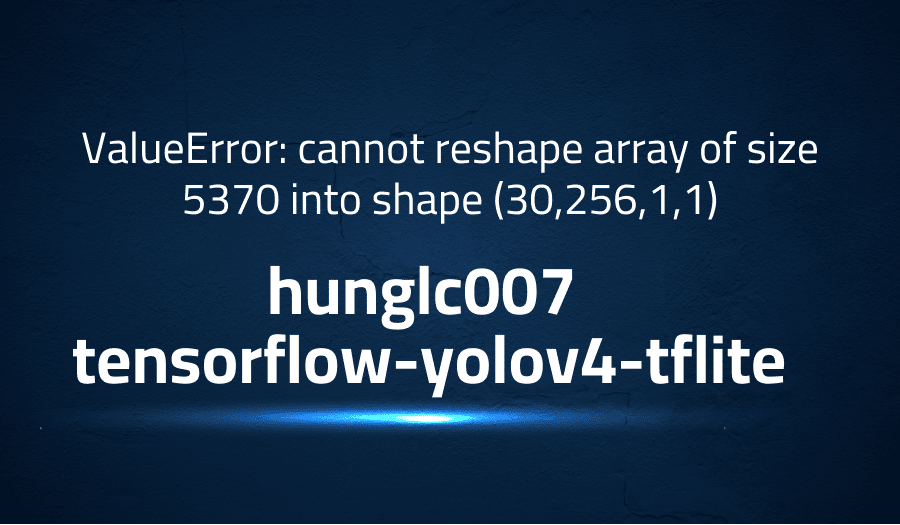

ValueError: cannot reshape array of size 5370 into shape (30,256,1,1) in hunglc007 tensorflow-yolov4-tflite
Explanation of the problem
Troubleshooting with the Lightrun Developer Observability Platform
Getting a sense of what’s actually happening inside a live application is a frustrating experience, one that relies mostly on querying and observing whatever logs were written during development.
Lightrun is a Developer Observability Platform, allowing developers to add telemetry to live applications in real-time, on-demand, and right from the IDE.
- Instantly add logs to, set metrics in, and take snapshots of live applications
- Insights delivered straight to your IDE or CLI
- Works where you do: dev, QA, staging, CI/CD, and production
Start for free today
Problem solution for ValueError: cannot reshape array of size 5370 into shape (30,256,1,1) in hunglc007 tensorflow-yolov4-tflite
This error message is related to the shape of the input tensor that is being passed to a function in the TensorFlow framework. The input tensor has a shape of (5370,) which cannot be reshaped into the desired shape of (30, 256, 1, 1).
The solution for this error involves ensuring that the input tensor has the correct shape before passing it to the function. This could be achieved by pre-processing the input data or changing the configuration parameters that are used to generate the input tensor.
In the case described in the problem, the configuration parameters are defined in the “config.py” file and the execution code is provided. Careful inspection and possible modifications of these two components could help resolve the issue.
Other popular problems with hunglc007 tensorflow-yolov4-tflite
Problem: TensorFlow Lite Interpreter Compatibility Issues
The TensorFlow Lite interpreter may not be compatible with the latest version of the YOLOv4 model, causing errors and crashes when running the model.
Solution:
It is recommended to update to the latest version of the TensorFlow Lite interpreter to ensure compatibility. If that doesn’t work, try downgrading the version of the YOLOv4 model to an earlier version that is compatible with the TensorFlow Lite interpreter.
Problem: Input Shape Mismatch Error
An input shape mismatch error occurs when the shape of the input image passed to the YOLOv4 model does not match the expected shape defined in the model’s configuration file.
Solution:
Verify that the input image shape matches the expected shape defined in the model’s configuration file, and resize the image if necessary. Also, make sure that the input image is in the correct format, such as RGB or BGR.
Problem: Performance Degradation with Large Model Sizes
The YOLOv4 model may experience performance degradation when the model size is too large, causing slow inference times and high memory usage.
Solution:
To improve performance, try optimizing the model by reducing the number of parameters and layers, or by using pruning techniques. Another solution is to run the model on hardware that is optimized for deep learning, such as GPUs or TPUs
A brief introduction to hunglc007 tensorflow-yolov4-tflite
hunglc007 tensorflow-yolov4-tflite is an open-source project that implements YOLOv4, a state-of-the-art object detection model, using TensorFlow and TensorFlow Lite. YOLOv4 is a deep learning-based model that can detect objects in real-time with high accuracy. The project is designed to be easy to use, with a focus on fast and efficient object detection for a wide range of use cases, such as security and surveillance, self-driving cars, and image processing.
The implementation of YOLOv4 in hunglc007 tensorflow-yolov4-tflite is optimized for deployment on mobile devices, with the use of TensorFlow Lite. TensorFlow Lite is a lightweight and efficient framework for running deep learning models on resource-constrained devices, such as smartphones and Raspberry Pis. This optimization allows for the deployment of the object detection model in real-time, even on devices with limited computational resources. The project also includes pre-trained weights and example code for object detection, making it easy for developers to get started with object detection using YOLOv4 and TensorFlow Lite.
Most popular use cases for hunglc007 tensorflow-yolov4-tflite
- Object Detection in Real-time: hunglc007 tensorflow-yolov4-tflite can be used to detect objects in real-time using a webcam or video feed. The model can be integrated into a computer vision pipeline, allowing for the detection of objects in real-time as the video is being captured.
import cv2
import numpy as np
# Load the TensorFlow Lite model
interpreter = tf.lite.Interpreter(model_path="yolov4.tflite")
interpreter.allocate_tensors()
# Get input and output tensors
input_details = interpreter.get_input_details()
output_details = interpreter.get_output_details()
# Open the video capture
cap = cv2.VideoCapture(0)
while True:
# Capture a frame from the video
ret, frame = cap.read()
# Preprocess the frame for input to the TensorFlow Lite model
frame = cv2.resize(frame, (416, 416))
frame = np.expand_dims(frame, axis=0)
# Run the TensorFlow Lite model
interpreter.set_tensor(input_details[0]['index'], frame)
interpreter.invoke()
# Get the results from the model
boxes = interpreter.get_tensor(output_details[0]['index'])
classes = interpreter.get_tensor(output_details[1]['index'])
scores = interpreter.get_tensor(output_details[2]['index'])
# Draw the bounding boxes on the frame
for i in range(boxes.shape[1]):
if scores[0, i] > 0.5:
x1, y1, x2, y2 = boxes[0, i]
cv2.rectangle(frame, (x1, y1), (x2, y2), (0, 0, 255), 2)
# Show the frame
cv2.imshow("Object Detection", frame)
if cv2.waitKey(1) & 0xFF == ord('q'):
break
# Release the video capture
cap.release()
cv2.destroyAllWindows()
- Image Classification and Segmentation: In addition to object detection, hunglc007 tensorflow-yolov4-tflite can also be used for image classification and segmentation tasks. The model can be fine-tuned on a specific task or dataset, allowing for highly accurate results in these areas.
- Autonomous Systems: hunglc__ tensorflow-yolov4-tflite can be used in autonomous systems, such as self-driving cars, to detect objects in the environment and make decisions based on that information. The ability to run object detection in real-time on resource-constrained devices makes it an ideal choice for deployment in these types of systems.
It’s Really not that Complicated.
You can actually understand what’s going on inside your live applications.




